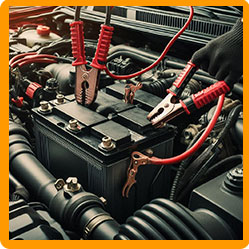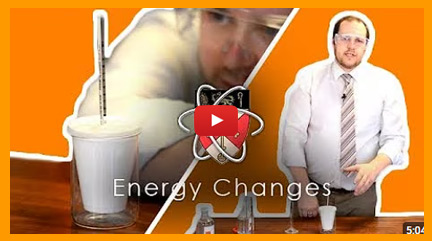
Energy Changes
Energy changes are a key part of chemical reactions. Whether a reaction gives off heat or takes it in, energy is always transferred — and understanding these transfers helps us explain how reactions work, power our devices, and even fuel vehicles.
Practicals on this page:
Temperature changes
Exothermic and Endothermic Reactions
Chemical reactions always involve energy changes. These are classified into two types:
- Exothermic reactions transfer energy to the surroundings, usually in the form of heat, making the surroundings warmer. The temperature increases.
Examples include: combustion (burning fuels), neutralisation (acid + alkali), and oxidation reactions. Everyday uses include self-heating cans and hand warmers. - Endothermic reactions absorb energy from the surroundings, making them cooler. The temperature decreases.
Examples include: thermal decomposition and reactions in cold packs used in sports injuries.
Energy Transfer in Chemical Reactions
Chemical reactions involve breaking old bonds and forming new ones:
- Breaking bonds between atoms requires energy — it’s endothermic.
- Making bonds releases energy — it’s exothermic.
The overall energy change depends on which process transfers more energy. If more energy is released than taken in, the reaction is exothermic. If more is absorbed, it’s endothermic.
Reaction Profiles (Energy Level Diagrams)
Reaction profiles are diagrams that show how the energy of a reaction changes as it progresses:
- Exothermic reactions show a drop in energy from reactants to products.
- Endothermic reactions show a rise in energy from reactants to products.
- The activation energy is the minimum amount of energy needed to start the reaction. It appears as a peak between the reactants and products.
These diagrams are useful for visualising how much energy a reaction needs to begin and how much it gives out or takes in.
Revision Notes

The Cornell method is like a supercharged note-taking system that helps you ace your revision!
Print out our blank revision notes pages to help you revise.
How to make effective revision notes with the Cornell method.
Exam Questions & Answers

Download and print off practice our FREE worksheet with exam style questions on Cell Biology.
Bond Energy Calculations
We can calculate the overall energy change of a reaction using average bond energies:
Overall energy change = Total energy to break bonds – Total energy to form bonds
- If the result is negative, it’s an exothermic reaction.
- If it’s positive, it’s endothermic.
Cells and Batteries
A chemical cell produces electricity through a chemical reaction between two different metals (electrodes) and an electrolyte (an ionic solution).
- The voltage of a cell depends on the difference in reactivity between the two metals.
- A battery is simply two or more cells joined together in series to produce a larger voltage.
Some batteries, like those in mobile phones, are rechargeable — their chemical reactions can be reversed by an electric current. Others, like those in remote controls, are non-rechargeable and must be replaced when they run out.
Fuel Cells
A fuel cell is a device that produces electricity through a chemical reaction between a fuel (usually hydrogen) and oxygen. In the hydrogen-oxygen fuel cell:
- Hydrogen is oxidised at the anode.
- Oxygen is reduced at the cathode.
- The only waste product is water.
This is a redox reaction, meaning it involves both reduction and oxidation. Fuel cells are efficient, long-lasting, and environmentally friendly compared to conventional batteries or combustion engines.
Hydrogen Fuel Cells in Vehicles
Hydrogen fuel cells are being developed for use in cars, buses, and even space travel. They offer several advantages:
- No harmful emissions — just water vapour.
- High efficiency and quiet operation.
- Quick refuelling times, compared to long charging times for batteries.
However, there are also challenges:
- Hydrogen is flammable and needs careful storage.
- Production of hydrogen can be expensive or involve fossil fuels.
Still, hydrogen fuel cells are a promising technology for clean, green transport.
Also see Rates of Chemical Change, Energy Changes, Electrolysis
PRACTICAL - Temperature Changes
In this practical, you'll investigate how the temperature changes during an exothermic or endothermic reaction. Typically, this involves measuring the temperature change when an acid reacts with an alkali or another substance.
You’ll:
- Measure a fixed volume of one reactant (e.g. hydrochloric acid) using a measuring cylinder
- Add it to a polystyrene cup placed in a beaker for insulation
- Record the starting temperature
- Add the second reactant (e.g. sodium hydroxide) and stir
- Measure the highest or lowest temperature reached, depending on the reaction
You can repeat the experiment with different concentrations or volumes to see how the energy change varies.
Revision Notes

The Cornell method is like a supercharged note-taking system that helps you ace your revision!
Print out our blank revision notes pages to help you revise.
How to make effective revision notes with the Cornell method.
Why Do I Need to Know About Energy Changes?
In Everyday Life
- Knowing how batteries work and why some are rechargeable and others are not
- Understanding how fuel cells and electric vehicles work and affect the environment
- Choosing between heat packs or cold packs based on the type of energy change
- Interpreting how energy is transferred in things like cooking, combustion, and insulation
- Understanding climate-friendly technologies like hydrogen-powered cars or clean energy sources
- Making informed decisions about energy efficiency and sustainable living
In Science & Chemistry Careers
- Designing batteries and fuel cells for portable devices, electric cars, and renewable energy storage
- Calculating energy transfers to make industrial processes safer and more efficient
- Developing green technology with better energy profiles and reduced environmental impact
- Creating more efficient heating/cooling systems using principles of exothermic/endothermic reactions
- Understanding reaction profiles and bond energy in pharmaceutical and materials research
- Working on advanced fuel systems in aerospace, transport, and sustainable energy sectors



